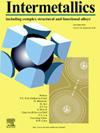Achieving an excellent strength-ductility synergy in a medium-entropy alloy by a suitable thermo-mechanical processing
IF 4.8
2区 材料科学
Q2 CHEMISTRY, PHYSICAL
引用次数: 0
Abstract
In this study, we present a Co2Ni2Cr medium-entropy alloy (MEA) co-doped with Al/Mo, and systematically regulate its microstructure through thermo-mechanical processing. A representative (Co2Ni2Cr)88Al8Mo4 MEA, fabricated via cold rolling followed by annealing at 765 °C, exhibits an excellent strength-ductility synergy. It achieves a high yield strength of ∼1150 MPa, an ultimate tensile strength of ∼1397 MPa, and maintains a good ductility of ∼17 %. The representative MEA undergoes partial recrystallization, with high-density L12 nanoparticles uniformly distributed in both recrystallized and non-recrystallized regions. Furthermore, EBSD analysis reveals the presence of high-density dislocations within the non-recrystallized region. Therefore, precipitation strengthening by L12 nanoparticles and dislocation strengthening are likely the primary mechanisms contributing to the high yield strength observed in the representative MEA. Simultaneously, its excellent ductility can be attributed to the highly coherent two-phase interface, the presence of high-density microbands and Lomer-Cottrell (LC) locks, as well as a certain proportion of recrystallized regions. Therefore, this study presents an effective design strategy to achieve an excellent strength-ductility synergy in a MEA through optimized thermo-mechanical processing.
通过适当的热机械加工,在中熵合金中获得优异的强度-塑性协同效应
在本研究中,我们制备了一种Co2Ni2Cr中熵合金(MEA),并与Al/Mo共掺杂,并通过热机械加工系统地调节其显微组织。冷轧后765℃退火制备的(Co2Ni2Cr)88Al8Mo4 MEA具有优异的强度-延展性协同效应。它的屈服强度达到1150mpa,极限抗拉强度达到1397mpa,并保持了17%的良好延展性。具有代表性的MEA经历了部分再结晶,高密度L12纳米颗粒均匀分布在再结晶区和非再结晶区。此外,EBSD分析显示,在非再结晶区域内存在高密度位错。因此,L12纳米颗粒的析出强化和位错强化可能是具有代表性的MEA中观察到的高屈服强度的主要机制。同时,其优异的延展性可归因于高相干的两相界面,高密度微带和lomo - cottrell (LC)锁的存在,以及一定比例的再结晶区域。因此,本研究提出了一种有效的设计策略,通过优化热机械加工,在MEA中实现良好的强度-塑性协同。
本文章由计算机程序翻译,如有差异,请以英文原文为准。
求助全文
约1分钟内获得全文
求助全文
来源期刊

Intermetallics
工程技术-材料科学:综合
CiteScore
7.80
自引率
9.10%
发文量
291
审稿时长
37 days
期刊介绍:
This journal is a platform for publishing innovative research and overviews for advancing our understanding of the structure, property, and functionality of complex metallic alloys, including intermetallics, metallic glasses, and high entropy alloys.
The journal reports the science and engineering of metallic materials in the following aspects:
Theories and experiments which address the relationship between property and structure in all length scales.
Physical modeling and numerical simulations which provide a comprehensive understanding of experimental observations.
Stimulated methodologies to characterize the structure and chemistry of materials that correlate the properties.
Technological applications resulting from the understanding of property-structure relationship in materials.
Novel and cutting-edge results warranting rapid communication.
The journal also publishes special issues on selected topics and overviews by invitation only.
 求助内容:
求助内容: 应助结果提醒方式:
应助结果提醒方式:


